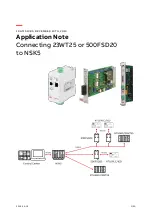
G.703 Clock Extension
Mobile networks require precise synchronization of base stations, which is a challenge when using IP backhaul. Most operators are
forced to use GPS-based external equipment for site synchronization. CDM-570/L-IP offers a G.703 clock extension option that
propagates a high stability reference from hub to the remote. This process does not require additional bandwidth.
FAST Feature Enhancements
The FAST codes make it easy to upgrade the modem capability in the field. New features can be added on site, using FAST access
codes purchased from Comtech EF Data that can be entered via the front panel.
IP Module
With its innovative architecture and support for advanced capabilities, IP Module-equipped versions of the CDM-570/L allow for efficient
IP networking and transport over satellite. The CDM-570/L-IP supports a wide range of applications and network topologies.
Header Compression Option
Configurable on a per route basis, header compression reduces the bandwidth required for VoIP by as much as 60%. Example: A G.729
voice codec, operating at 8 kbps, requires 32 kbps bandwidth once encapsulated into an IP/UDP/RTP frame. With compression, the
same voice call needs only 10.8 kbps total WAN satellite bandwidth. Typical Web/HTTP traffic can also be reduced by 10% via IP/TCP
header compression.
Payload Compression Option
Configurable on a per route basis, payload compression can reduce the required satellite bandwidth by up to 40%.
Quality of Service (QoS) Option
The modems support multi-level QoS to reduce jitter and latency for real time traffic, provides priority treatment to mission critical
applications and allows non-critical traffic to use the remaining bandwidth. Supported modes are:
•
DiffServ – Industry-standard method of providing QoS enabling seamless co-existence in networks that implement DiffServ.
•
Max/Priority – Provides eight levels of traffic prioritization with the ability to limit maximum traffic per priority class
•
Min/Max – Provides a Committed Information Rate (CIR) to each user defined class of traffic with the ability to allow a higher
burstable rate depending on availability
Vipersat Management System
•
Dynamic SCPC carrier allocation & true bandwidth-on-demand
•
User-defined policies for upstream carrier switching
•
Star and full mesh capabilities using single hop on-demand
•
Advanced switching takes advantage of using other modulation/forward error correction combinations
•
Guaranteed bandwidth capability
VMS Network & Bandwidth Management
A Vipersat-powered network integrates these advanced modems with a powerful network management tool, the Vipersat Management
System (VMS). In addition to the traditional monitoring and control of the CDM-570/L-IP modems and the CDD-564/L and CDD-562L
demodulators, the VMS allows these devices to share bandwidth, and when needed, switch automatically to a dedicated SCPC channel.
In a Vipersat-powered network, the CDM-570/L-IP modem takes advantage of its fast acquisition demodulation to allow it to operate in a
shared mode. Inbound transmissions (from remote to hub) can be switched from a shared Selective Time Division Multiple Access
(STDMA) mode to a dedicated Single Carrier Per Channel (SCPC) connection via a variety of user defined policies or triggers. This
enables the network to more effectively handle real-time connection-oriented applications and reduces both latency and network
congestion. Through VMS, dynamic point-to-point mesh connections can also be established between remotes.
Upstream Switching
Through protocol classification in the remote terminals, the modem initiates automatic switching. VMS establishes
dSCPC
bandwidth
based on policies that can be individually enabled on a per-remote basis, or globally enabled. Policies can be configured for a variety of
applications such as VoIP, video (VTC), or based on a load, or via a schedule, Type of Service (ToS), or QoS rules such as IP port or IP
address and protocol type. Operators are able to set minimum and maximum data rates for each remote as well as excess data rates for
an initial upstream switch.
Vipersat Operation Mode
Vipersat operation is enabled via a FAST feature code. Networks can easily start off in point-to-point or point-to-multipoint configurations.
As the network grows and users wish to take advantage of the bandwidth on-demand savings by implementing a Vipersat network,
modems can easily be upgraded to Vipersat mode. Vipersat mode provides for the ability to operate in the following modulation/FEC
rates:
STDMA
QPSK, Rate 3/4 Turbo FEC – all STDMA modes
Data Rate Range: 64 kbps – 4.5 Mbps
BPSK, Rate 5/16 Turbo FEC – Entry Channel Mode only
Data Rate Range: 32 kbps to 937 kbps
SCPC
All Turbo Product Code FEC rates as detailed in the following specifications






















